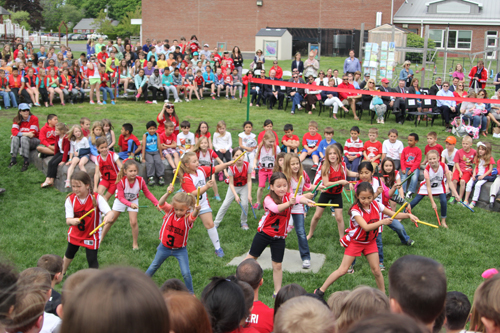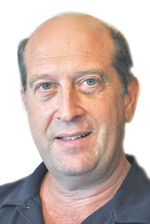Guest Spot: A place to create, discover and share


Words matter. They matter in all aspects of life, especially when we are talking about how to define a school. Of course, brick and mortar are only a small part of the story.
The academic and emotional climate, both inside and outside the physical space, gets us closer to an understanding of what forms the basis of any school. Throughout our country, we have many opinions, positions, and reform efforts competing to control the narrative not only of what defines a school, but also, more significantly, of what it means to be educated in 2016 and beyond.
My daily travels in the schoolhouse as a superintendent give me an inside look at what constitutes a school. I am fortunate that my professional work over the last 30 years has put me inside dozens of schools and in contact with hundreds of educators, scholars and support staff. I have also had the good fortune to be in the company of thousands of children and their families. No, I do not consider myself an expert on all things that define a school. I do, however, have a vested interest in seeing that the schools of today and those that are created in the future are shaped with the care and respect they so richly deserve.
The call to have children as young as 8 or 9 years old “college- and career-ready” does not create the same narrative as building a sound foundation in childhood filled with play and creativity. Among the many other more important ways to engage the hearts and minds of our youngest students, we must promote the childhood experience in all its wonder.
Schools have always existed as an expression of how a given community values its children, and how a society looks at the future — a covenant handed down from one generation to the next. The problems that beset our social, political and economic well-being as a nation are, in fact, not born at the doorsteps of our schools. They are certainly not derived exclusively from the province of our public schools. The crumbling roads, bridges and tunnels of the infrastructure that is the lifeblood of a thriving economy demand our attention, as does the scourge of substance abuse wreaking havoc on families of every demographic group.
Local neighborhood and even family issues that confront all generations, from toddlers to senior citizens, are ever-present in our daily lives. If schools do play a part in shaping our future — and I believe they do — how we articulate the issues matters as much as how we marshal the will and resources to meet these challenges.
The calls to shutter schools, to replace and dismantle them, are being offered by those with a variety of other interests. These are not the solutions we should accept. They create a hostile dialogue that reflects the worst in our democratic discourse. In the last 10 years, we have witnessed a rapid decline in civility, an unfettered belligerent approach to the questions central to the teaching and learning process.
Words matter in how we discuss our schools and the issues that confront all communities. How this conversation occurs has changed in recent decades across the entire country, from small rural towns to large suburban and urban communities. Technology affords us wonderful ways to gather data points that could promote change, but it may still fail to foster a deliberative and thoughtful dialogue regarding the seeds of our problems. The most basic elements of our humanity must not get lost in the pursuit of a faster, data-driven decision-making process. Such is a key element of our current fascination with a punitive, high-stakes testing environment designed to sort and select students and teachers.
So, what truly defines a school? For me, the exchange between child and adult is at the heart of it. That exchange may be subtle or vigorous — not rigorous. Rigor, which shares roots with the Latin rigor mortis, implies severity, rigidity and stiffness — all connotations that restrict the learner and the learning process — while vigor implies energy and dynamism.
Yes, words matter. The best learning occurs when both teacher and student are in pursuit of a deeper understanding. It is a quest that is based on love, one that is filled with authentic, joyful, challenging and impactful experiences. A school is a place of respect and wonder.
The search to create, discover, reveal and share is an unending journey that occurs in the best of our schools: the child immersed in beautiful poetry, the student acquiring the skill of using a watercolor-paint brush, the rendering of a museum-quality display of artifacts. Scientific experiments, research papers, debates and discussions centered on classic literature are the means through which students explore and discover ideas. Unpacking the essential elements of contemporary issues and having students learn to take responsibility for their actions coalesce to teach valuable lessons that extend beyond the school walls. Students who present their learning before a panel of adjudicators and get so immersed that they lose track of time are then at their optimal disposition to learn. No reward or punishment necessary.
All members of a community, from custodians to teachers and principals to kindergartners, are the learners of a true school. A climate of fear and hostility, or a tone of acrimony and mistrust, will yield neither a school that serves the needs of children nor the globally competitive country that some imagine will arrive when we replace the old with the new. Schools of the future — no matter their size, technological sophistication, or cost-effectiveness — should always begin with the best qualities of our humanity.
We must choose our words carefully in this fight. We must strive to retain the core values that define a school as a place that upholds the tenets of our democracy and cares about people, rather than a place that efficiently manages the system or pits stakeholders against one another. “Education,” in the words of John Dewey, “is a process of living and not a preparation for future living.”
Top photo: The unveiling of Southold Elementary School’s amphitheater in May 2015. (Credit: Jen Nuzzo, file)
 The author is the superintendent of the Southold and Greenport school districts. This column first appeared in Education Week on March 30, 2016. It was reprinted with permission from the author and the publication.
The author is the superintendent of the Southold and Greenport school districts. This column first appeared in Education Week on March 30, 2016. It was reprinted with permission from the author and the publication.








